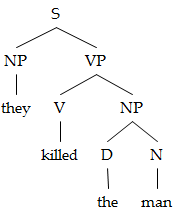Syntax
| Line 1: | Line 1: | ||
| − | In Linguistics, '''syntax''' is "the study of the principles and processes by which sentences are constructed in particular languages"<ref> Chomsky, Noam. [1957]. Syntactic Structures. p. 11.</ref>. It assumes that: | + | In Linguistics, '''syntax''' is "the study of the principles and processes by which sentences are constructed in particular languages"<ref name="1"> Chomsky, Noam. [1957]. Syntactic Structures. p. 11.</ref>. It assumes that: |
*natural language sentences can be broken down into components (the so-called syntactic constituents); | *natural language sentences can be broken down into components (the so-called syntactic constituents); | ||
*the resulting structure (i.e., the relations between syntactic constituents) is hierarchical (a tree-like structure) rather than a simple list; and | *the resulting structure (i.e., the relations between syntactic constituents) is hierarchical (a tree-like structure) rather than a simple list; and | ||
| Line 16: | Line 16: | ||
|align=center|(2) | |align=center|(2) | ||
|} | |} | ||
| + | |||
| + | == Immediate Constituent Analysis == | ||
| + | In linguistics, immediate constituent analysis or IC analysis is a method of sentence analysis that was first mentioned by Leonard Bloomfield<ref>Bloomfield, Leonard. 1933. Language. New York: Henry Holt</ref> and developed further by Rulon Wells<ref>Wells, Rulon S. 1947. "Immediate Constituents." Language: 23. pp. 81–117.</ref>. The process reached a full blown strategy for analyzing sentence structure in the early works of Noam Chomsky<ref name="1"/>. The practice is now widespread. Most tree structures employed to represent the syntactic structure of sentences are products of some form of IC-analysis. The process and result of IC-analysis can, however, vary greatly based upon whether one chooses the constituency relation of phrase structure grammars (= constituency grammars) or the dependency relation of dependency grammars as the underlying principle that organizes constituents into hierarchical structures. | ||
== Notes == | == Notes == | ||
<references /> | <references /> | ||
Revision as of 21:42, 13 August 2013
In Linguistics, syntax is "the study of the principles and processes by which sentences are constructed in particular languages"Cite error: Invalid <ref> tag;
name cannot be a simple integer. Use a descriptive title. It assumes that:
- natural language sentences can be broken down into components (the so-called syntactic constituents);
- the resulting structure (i.e., the relations between syntactic constituents) is hierarchical (a tree-like structure) rather than a simple list; and
- the structure can be predicted by rules (i.e., the structure is regular), which consist the grammar of the language.
For instance, the sentence:
they killed the man
is more productively represented as (1) than (2)

|
[they][ ][killed][ ][the][ ][man] | |
| (1) | (2) |
Immediate Constituent Analysis
In linguistics, immediate constituent analysis or IC analysis is a method of sentence analysis that was first mentioned by Leonard Bloomfield[1] and developed further by Rulon Wells[2]. The process reached a full blown strategy for analyzing sentence structure in the early works of Noam ChomskyCite error: Invalid <ref> tag;
name cannot be a simple integer. Use a descriptive title. The practice is now widespread. Most tree structures employed to represent the syntactic structure of sentences are products of some form of IC-analysis. The process and result of IC-analysis can, however, vary greatly based upon whether one chooses the constituency relation of phrase structure grammars (= constituency grammars) or the dependency relation of dependency grammars as the underlying principle that organizes constituents into hierarchical structures.